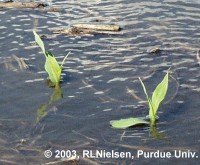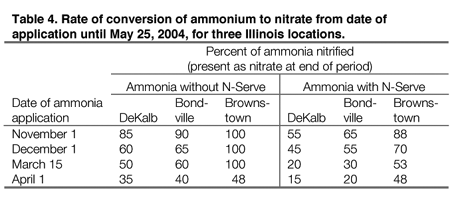

![]()
![]() The Printer-Friendly version (PDF format) of this article is compatible with
Adobe Reader for PocketPC. Click on the Adobe button for information on how
to download, install, and use Reader for Pocket PC. Please let me know whether
this user option is useful to you.
The Printer-Friendly version (PDF format) of this article is compatible with
Adobe Reader for PocketPC. Click on the Adobe button for information on how
to download, install, and use Reader for Pocket PC. Please let me know whether
this user option is useful to you.
Bottom Line
 Estimating N loss
due to soggy soil events is a complicated procedure and not terribly accurate.
Estimating N loss
due to soggy soil events is a complicated procedure and not terribly accurate.
![]() orrential
rainfall events in the past few weeks, particularly in southern Indiana, have
caused some corn growers to question whether supplemental nitrogen fertilizer
may be required because of their concern that some of the pre-plant nitrogen
has been "lost" by leaching or denitrification. The question is a
valid one because soil nitrogen in the nitrate form can disappear at rates as
high as 5% per day of ponding or saturated soil conditions.
orrential
rainfall events in the past few weeks, particularly in southern Indiana, have
caused some corn growers to question whether supplemental nitrogen fertilizer
may be required because of their concern that some of the pre-plant nitrogen
has been "lost" by leaching or denitrification. The question is a
valid one because soil nitrogen in the nitrate form can disappear at rates as
high as 5% per day of ponding or saturated soil conditions.
Unfortunately, the answer to the question is often clouded by many complicating factors. Among them are nitrogen fertilizer source, time of fertilizer application, soil temperatures since the time of application, use or not of a nitrification inhibitor, use or not of an urease inhibitor, calendar time since time of application, amount of rainfall, timing of rainfall, duration of saturated soil conditions, soil temperatures during the period of saturated soil conditions, and soil texture. Add to this list the uncertainty regarding the yield potential of the corn that survived the soggy conditions.
Nitrogen fertilizer exists in several forms; including ammonium, urea, and nitrate. Since the nitrate form of soil nitrogen is the one vulnerable to loss by leaching or denitrification, estimating how much of the applied nitrogen fertilizer was in the nitrate form when the rainy period began is important to estimating how much nitrogen may have been lost.
Ammonium and urea forms of nitrogen eventually convert to the nitrate form via soil microbial processes. The rates of conversion are dependent on soil temperature and aeration. About one-fourth of urea-ammonium-nitrate solution (28% UAN) is already in the nitrate form and is susceptible to leaching or denitrification loss as soon as the material is applied to the field.
Urea can convert to the ammonium form of nitrogen in 4 to 7 days with warm soil temperatures and adequate soil moisture (Kissel, 1988 ). Once in the ammonium form, conversion to the nitrate form can occur in only one to two weeks with continued warm temperatures and, importantly, aerated soils (Brouder & Joern, 1998). Given that soil temperatures have averaged well above 60F since early May for most of central Indiana and perhaps mid-April in parts of southern Indiana (Scheeringa, 2004), it is likely that UAN applied in March and April had converted nearly completely to the nitrate form of nitrogen prior to the soggy soil events of the last couple weeks.
Conversion of anhydrous ammonia to nitrate occurs more slowly because the anhydrous band itself is toxic to the soil microbes responsible for the conversion. The soil microbial population must rebuild over a several week period before the conversion to nitrate can begin and so nitrification is delayed from two to six weeks (Brouder & Joern, 1998). Recognize that conversion of ammonium to nitrate is interrupted when soils become saturated.
Having said all that, let’s return to the question of how much nitrogen loss has likely occurred so far this spring. Since the conversion of ammonium to nitrate is strongly temperature dependent, one can estimate conversion rates based on soil temperatures since the time of fertilizer application. Bob Hoeft (Univ. of Illinois) offers the following estimates of conversion from ammonium to nitrate forms of nitrogen for anhydrous ammonia application applied at four dates at three Illinois locations. The locations in the table represent northern (Dekalb), central (Bondville), and southern (Brownstown) areas of Illinois.

Table originally published in Hoeft,
2004.
Acknowledging state-to-state differences in geography, soils, and climate; Indiana growers can nevertheless use the Illinois data to approximate rates of ammonium conversion to nitrate for areas of Indiana that correspond north/south with those areas of Illinois.
The next step in this tortuous estimation process is to predict the rate of denitrification loss during the past couple of weeks. According to Univ. of Illinois data (Hoeft, 2004), denitrification rates range from 1 to 2 % per day at soil temperatures less than 55F, 2 to 3 % per day at soil temperatures between 55 and 65F, and 4 to 5 % per day at soil temperatures greater than 65F. The latter, higher, rates are applicable to soggy soil events throughout most of Indiana during the past couple of weeks since soil temperatures have averaged 65F or greater during that time period (Scheeringa, 2004).
Remember that the estimate of nitrogen loss is equal to the mathematical product of the estimated pounds of available soil nitrate multiplied by the estimated denitrification rate multiplied by the estimated number of days of saturated soil conditions. Example calculations of N loss estimates for three scenarios, each assuming an initial nitrogen fertilizer application rate of 180 lbs. N per acre and seven days of saturated soils, are listed here. Estimates of available nitrate are applicable for the late May time period.
These estimates of nitrogen loss can then be used to determine the rates of supplemental nitrogen that could be applied to the corn crop. As you might expect by now in this discussion, the decision about supplemental N fertilizer is not straightforward either because of uncertainties involved with the health of corn that has been subjected to ponding or saturated soils.
Frankly, the prospects for corn that has been ponded or subjected to saturated soils for more than three or four consecutive days are not positive at all. Similarly, corn that has suffered repeated ponding or flooding events would not be in good shape. Root death due to oxygen deprivation and/or disease will stunt or kill the waterlogged plants.
The worst of the wet holes or river bottoms will require replanting or will remain barren the remainder of this season. In many cases, the yield potential of the corn crop will be dramatically lower than hoped for and the remaining soil nitrogen levels are probably adequate to support that now lower yield level. Supplemental nitrogen fertilizer application would probably not be beneficial.
If you decide to apply supplemental nitrogen, remember that the very nature of flooding or ponding is spatial in its variability. If supplemental nitrogen fertilizer application was deemed to be economically valuable for the affected crop, the application itself will also need to be spatial and not performed over the entire field. The tire traffic involved with applying supplemental nitrogen to the affected spots in the field may damage otherwise healthy plants in the remainder of the field and create undesirable soil compaction.
You could elect to pull soil samples for a Pre-sidedress Soil Nitrate Test (PSNT) that may help predict the need for supplemental nitrogen. Information about this soil sample test can be found in the Purdue Extension publication AY-314-W (Brouder, 2003). Be aware, however, that the PSNT is best suited for estimating soil nitrogen availability in high organic matter soils or fields that have received manure applications. Use of the test for other situations has its limitations, including the fact that the standard 1-foot soil sample depth will not identify soil nitrate that may have leached to greater depths but is still available to plant roots. Additionally, the challenge of pulling representative soil samples in fields where pre-plant nitrogen fertilizer has already been applied is daunting because of the need to sample sequentially across the nitrogen applicator row widths. For suggestions on soil sampling such fields, read Bob Hoeft's suggestions.
Finally, you could forget all the discussion up to this point and instead monitor the surviving or replanted plants for symptoms of nitrogen deficiency. Areas of fields that exhibit distinct symptoms of nitrogen deficiency (leaf yellowing, especially if approaching ear leaf height) prior to pollination may benefit from roughly 50 lbs of supplemental nitrogen. Sources and application methods for supplemental fertilizer application to tall corn are discussed in Bob Hoeft's article.
Brouder, Sylvie. 2003. The Pre-Sidedress Soil Nitrate Test for Improving N Management in Corn. Purdue Univ. Cooperative Extension Service publication AY-314-W. Online at http://www.agry.purdue.edu/ext/pubs/AY-314-W.pdf. [URL verified 6/2/04].
Brouder, Sylvie and Brad Joern. 1998. Predicting Early Season N Loss. Purdue Univ. Online at http://www.kingcorn.org/news/articles.98/smb9802.html [URL verified 6/2/04].
Brouder, Sylvie and David Mengel. 2003. Determining Nitrogen Fertilizer Sidedress Application Needs in Corn Using a Chlorophyll Meter. Purdue Univ. Cooperative Extension Service publication AY-317-W. Online at http://www.agry.purdue.edu/ext/pubs/AY-317-W.pdf. [URL verified 6/2/04].
Hoeft, Robert. 2004. Predicting and Measuring Nitrogen Loss. Univ. of Illinois "the Bulletin". Available online at http://www.ipm.uiuc.edu/bulletin/article.php?issueNumber=10&issueYear=2004&articleNumber=8 (URL verified 6/2/04).
Kissel, David. 1988. Management of Urea Fertilizers. North Central Regional Publication NCR-326. Available online at http://www.oznet.ksu.edu/library/crpsl2/NCR326.pdf (URL verified 6/2/04).
Mullen, Robert. 2004. Denitrification of Applied Nitrogen and Sidedressing Considerations. Ohio State Univ. C.O.R.N. Available online at http://corn.osu.edu/index.php?setissueID=39#B (URL verified 6/2/04).
Rehm, George. 2004. May Rains and Potential for Nitrogen Loss. Minnesota Crop eNews. Univ. of Minnesota Coop. Ext. Service. Available online at http://www.extension.umn.edu/cropenews/2004/04MNCN08.htm. (URL verified 6/4/04).
Sawyer, John. 2004a. Assessing nitrogen losses. Iowa State Univ. Integrated Crop Management Newsletter. Available online at http://www.ipm.iastate.edu/ipm/icm/2004/6-7-2004/assessnloss.html (URL verified 6/2/04).
Sawyer, John. 2004b. Nitrogen losses after the heavy rains. Iowa State Univ. Integrated Crop Management Newsletter. Available online at http://www.ipm.iastate.edu/ipm/icm/2004/6-7-2004/nloss.html (URL verified 6/2/04).
Scheeringa, Ken. 2004. Purdue Automated Agricultural Weather Stations Network. Purdue Univ. Agronomy Dept. Online at http://shadow.agry.purdue.edu/sc.zen-geog.html. (URL verified 6/2/04).
Warncke, Darryl and Carrie Laboski. 2004. Nitrogen losses due to excessive rainfall. Michigan State Univ. Field Crop Team Advisory Alert. Available online at http://www.ipm.msu.edu/CAT04_fld/FC05-27-04.htm#11 (URL verified 6/2/04).